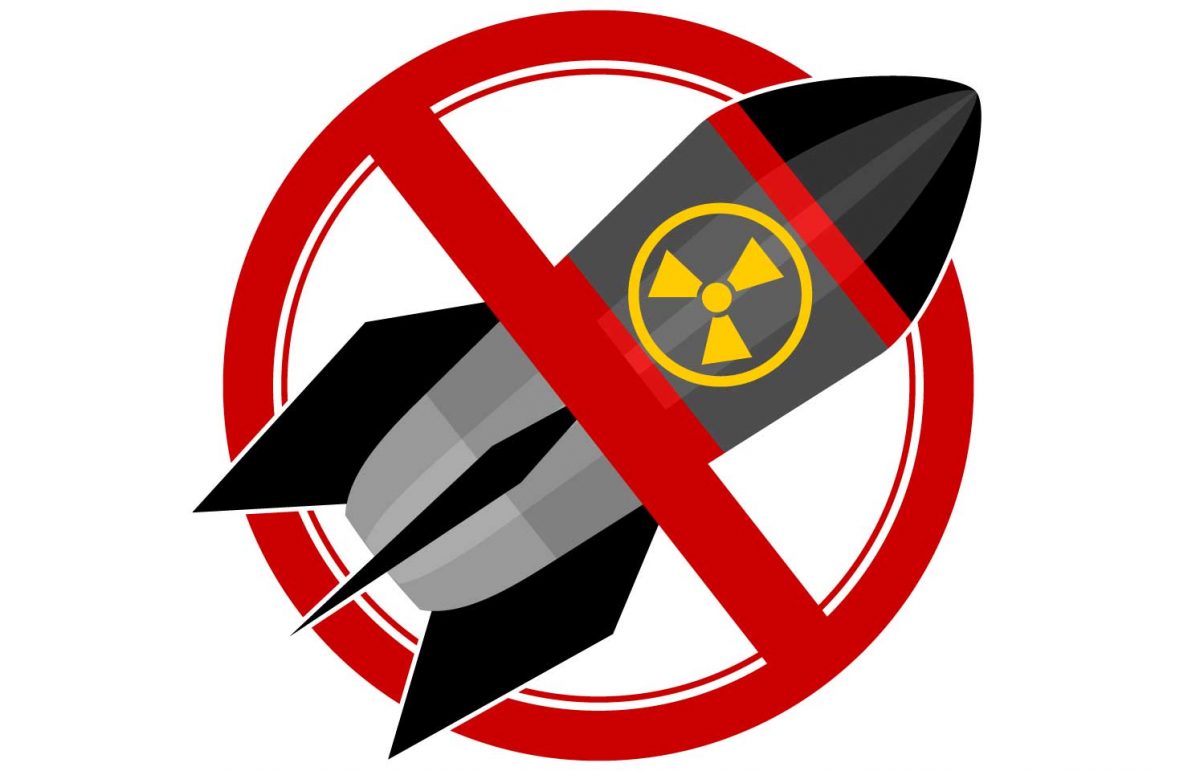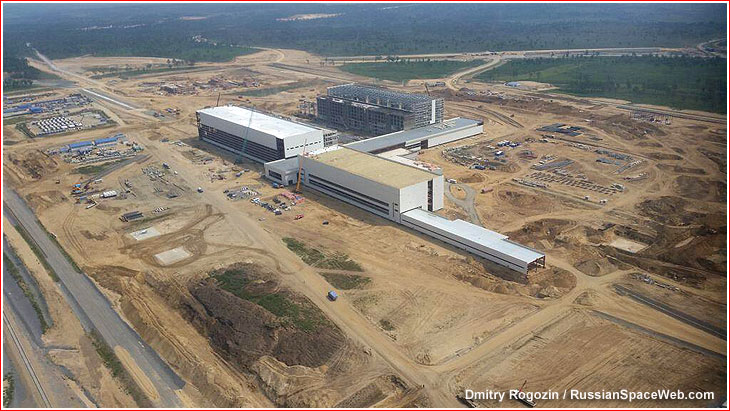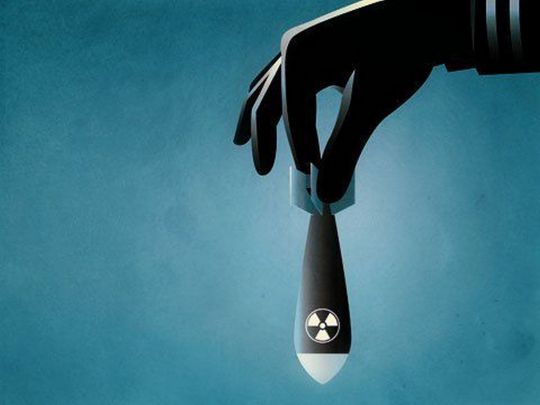
Amid ‘Concerns’ Over Alleged Russian Threat,
Rhe World Overlooks the Real Danger
Olga Sukharevskaya / RT News
(January 6, 2023) — Last year, Western media and high-ranking politicians actively discussed the possibility of Russian troops using atomic weapons in Ukraine. There has even been speculation on the likelihood of a nuclear war breaking out. However, it could be said that the risk is probably a lot higher on the other side of the barricades.
Ukraine’s Atomic History
Ukraine was a nuclear state after the collapse of the USSR, when 1,700 active atomic warheads remained in the country. Its politicians of that time had the prudence to abandon this status. The weapons were taken to Russia under international control, and their means of delivery were destroyed. Ukraine’s missile silos, with the exception of one, which is now a museum near Kiev, were blown up, while its strategic bombers capable of carrying nuclear weapons were either transferred to Russia or destroyed.
Despite this, there were still many nuclear specialists in Ukraine, as research into nuclear fission has been conducted in Kharkov since the 1930s. In addition, five nuclear power plants were built in Ukraine during the Soviet years: Zaporozhye, Rovno, Khmelnitsky, and South-Ukrainian, as well as the infamous Chernobyl, where an accident involving a power unit led to an explosion that spewed radioactive fallout throughout Europe.
In addition, uranium is extracted at a deposit in Ukraine’s Kirovograd Region and enriched at a plant in the city of Zheltye Vody. In the 2010s, there were plans with Russia’s Rosatom to build a plant in Ukraine that would produce fuel for nuclear power stations. However, these were abandoned after the Maidan coup in 2014, when the country adopted an adversarial stance towards Russia.

Vostochny Mining and Processing Plant.
At present, three of Ukraine’s five original nuclear power plants remain under its control. Chernobyl, which continued to generate electricity even after the 1986 accident, was finally decommissioned in 2020, while Zaporozhye, the largest nuclear power plant in Europe, has been guarded by Russian troops since last year. It is currently being run by Rosatom but does not produce electricity, largely for safety reasons. This is due to regular rocket and artillery attacks by Ukrainian troops, which have damaged numerous pieces of auxiliary equipment.
Push to Reobtain Nuclear Weapons
It should be noted that not everyone in Ukraine was happy that the country gave up its nuclear weapons. Ukrainian politicians have often failed to hide the fact that their dream of reobtaining nuclear weapons is not so much connected with their country’s security, as the desire to dictate their will to the rest of the world. Radical Ukrainian nationalists were particularly dissatisfied with the abandonment of the country’s nuclear status, and many of their manifestos contain a clause calling for it to be restored.
For example, “the return of nuclear weapons” is specifically cited as a goal in paragraph 2 of the Military Doctrine section in the program statement of the Patriot of Ukraine organization, while paragraph 7 of its Foreign Policy section reads: “The ultimate goal of Ukrainian foreign policy is world domination.” Patriot of Ukraine was created in 2014 by the notorious Andrey Biletsky, who formed it based on the ideology of the neo-Nazi Azov Battalion and had dreamed of Ukraine possessing nuclear weapons as far back as 2007.
In 2009, the Ternopil Regional Council, which was then dominated by Oleg Tianibok’s neo-Nazi Svoboda Party (called the Social-National Party until 2004), demanded that Ukraine’s president, prime minister, and head of the Verkhovna Rada “terminate the Budapest Memorandum of 1994 and retore Ukraine’s nuclear status.”
Ukraine’s longing for an atomic bomb especially increased after February 2014. In an interview with USA Today in March of that year, Ukrainian MP Pavel Rizanenko calledUkraine’s accession to the Treaty on the Non-Proliferation of Nuclear Weapons a “big mistake.” And that was not just the opinion of one MP. Just a few days later, representatives of the Batkivshchyna party, headed by ex-Prime Minister Yulia Timoshenko, and UDAR, headed by Kiev’s current mayor, Vitaly Klitschko, including the secretary of the parliamentary Committee on National Security and Defense, Sergey Kaplin, submitted a bill on withdrawing from the non-proliferation treaty. Kaplin claimed that Ukraine could create nuclear weapons in just two years because it already had almost everything necessary:
The fissile materials, equipment (except centrifuges), technology, specialists, and even means of delivery. In September of the same year, Ukraine’s minister of defense, Valery Geletey, also expressed the desire to develop nuclear weapons.

A Ukrainian member of the neo-Nazi Azov movement.
In December 2018, the former representative of the Ukrainian mission to NATO, Major General Pyotr Garashchuk, announced the real possibility of Ukraine creating its own nuclear weapons. In 2019, Aleksandr Turchinov, who usurped power in Ukraine in February of 2014, called Ukraine’s renunciation of nuclear weapons a “historic mistake.”Following him, in April 2021, the Ukrainian ambassador to Germany, Andrey Melnik, stated that if the West did not help Ukraine in its confrontation with Russia, the country would launch a nuclear program and create an atomic bomb.
And on February 19, 2022, before the start of Russia’s special military operation, Ukrainian President Vladimir Zelensky announced at the Munich Security Conference that Ukraine has the right to abandon the Budapest Memorandum, which proclaimed the country’s nuclear-free status.
Perhaps the most striking statement by a Ukrainian politician was made by David Arakhamia, the head of the Ukrainian parliament’s ruling parliamentary faction, Servant of the People. “We could blackmail the whole world, and we would be given money to service (nuclear weapons), as is happening in many other countries now,” he said in mid-2021.

Range of Possibilities
Is Ukraine technically capable of creating an atomic bomb? Absolutely. Yes, enriching uranium-235 to the purity necessary to set off a chain reaction would cost a lot, primarily to create centrifuges for separating isotopes. However, though this may be the most effective way to separate isotopes, it’s not the only one. The first American bombs dropped on Hiroshima and Nagasaki were created without the use of this technology.
In addition, it should not be forgotten that there are not only uranium, but also plutonium bombs. Breeder reactors are used to synthesize this chemical element, most often using heavy-water reactor technology, and research reactors are capable of producing weapons-grade plutonium.
There is presently a nuclear research installation at the Kharkov Institute of Physics and Technology, and a VVR-M reactor suitable for plutonium production at the Institute for Nuclear Research of Ukraine’s National Academy of Sciences in Kiev. Until March 2022, there was a US-built facility in Kharkov that could produce isotopes by irradiating the starting materials with a powerful neutron flux, which could also be used to develop fissile materials for a bomb.
In addition, Ukraine has the technical capability to create a nuclear weapon based on uranium-233, rather than uranium-235, which is usually used. A similar bomb was tested by the US in 1955 during Operation Teapot, and its power was comparable to that of the Fat Man bomb that destroyed the Japanese city of Nagasaki.
To obtain uranium-233, it is enough to replace one of the fuel assemblies of a conventional nuclear power plant reactor with a thorium-232 cassette, a supply of which is located near Mariupol, a city that was fiercely defended by Ukrainian nationalists from the Azov regiment earlier this year.
There is another indirect sign that both uranium and plutonium versions of nuclear weapons have been secretly developed at the direction of the post-Maidan authorities.
At the beginning of 2021, Ukraine completely banned the export of spent nuclear fuel (SNF) to Russia, as was required by an agreement on its supply by Rosatom. SNF, among other things, is a source of weapons-grade plutonium, which can be isolated from fuel cells that have been in a nuclear power plant reactor.

Nuclear installations have proliferated.
Nuclear Power on the Brink of Disaster
Just as dangerous is the nuclear power policy pursued by the Ukrainian government.
Ukraine inherited five nuclear power plants with 18 active reactors from the USSR. Three of them located at the Chernobyl NPP were decommissioned by 2000. Five of the six reactors at the Zaporozhye NPP, three of the four reactors at the Rovno NPP, one of the two reactors at the Khmelnitsky NPP, and all three reactors at the South Ukraine NPP have exceeded their original lifespans and received extensions of their operating lives for another 10 to 15 years.
The license extensions have sometimes been granted with violations of existing regulations since, after 2015, Ukraine’s State Nuclear Regulatory Inspectorate stopped cooperating with Russian vendors and has not overhauled reactor vessels, which become brittle after prolonged exposure to neutron radiation. Back in 2015, independent experts noted the critical condition of Reactor 1 of the South Ukraine NPP, which, nevertheless, has had its service life extended until 2025.
Ukraine’s Union of Veterans of Nuclear Energy and Industry sent a warning letter to the government in April 2020, arguing that the country’s nuclear energy sector was faced with a “threatening situation,” which, according to the authors of the letter, could well result in “a new Chernobyl.”
The lack of accountability, which led to the 1986 disaster, does not stop at neglecting the technical condition of the reactors that are not being properly monitored and maintained by their developers. During Viktor President Yushchenko’s administration, the decision was made to replace some of the standard fuel rods in Ukrainian reactors with unlicensed fuel assemblies supplied by Westinghouse Electric Company.
In 2012, that experiment led to an emergency shutdown of Reactor 3 of the South Ukraine NPP, after Westinghouse fuel assemblies were damaged due to the specific design features of the American counterfeits.
A huge map of the Ukraine in the colours of the national flag, is seen in front of the Yuzhnoukrainsk Nuclear Power Plant in the town Yuzhnoukrainsk, Mykolaiv region, 300 kilometres south of Kiev. © ANATOLII STEPANOV / AFP
That fuel assemblies fabricated by Westinghouse tend to malfunction in Soviet-designed reactors was not a revelation. They have repeatedly caused emergencies at NPPs in Finland, Hungary, the Czech Republic, and Slovakia, but that did not deter the Ukrainian leadership. Not even losses of around $175 million caused by using non-standard assemblies persuaded Ukraine against conducting risky experiments with its nuclear assets.
The new ‘revolutionary’ government, which came to power in 2014, was quick to plunge into its own experiments with nuclear power together with Westinghouse, which was suffering from financial distress. For the company, which filed for bankruptcy in 2017, the Ukrainian market could have been a much-needed lifeline – however, it wasn’t to be, because it once again emerged that the counterfeit fuel assemblies were dangerous for VVER-type reactors. Emergencies at Ukrainian NPPs became a routine event, and yet Westinghouse assemblies accounted for 46% of all nuclear fuel used in Ukraine by the end of 2018.
These risky experiments went beyond using non-standard fuel assemblies. In the fall of 2014, Kiev sent direct orders to boost electricity production at the South Ukraine NPP by 5 to 7%. To achieve this, three VVER-1000 reactors were supposed to operate in “controlled runaway mode,” and a whole algorithm was developed by Ukrainian and British engineers. It was this type of experiment that resulted in the explosion at the Chernobyl Nuclear Power Plant in 1986.
A potential disaster was only averted by an ‘Italian strike’ organized by the NPP personnel, who refused to fulfil outsiders’ orders. This might have been what former NATO Secretary General Anders Fogh Rasmussen meant when he said: “We have, upon Ukrainian request, sent a small team of civilian experts to Ukraine to assist the Ukrainians in improving security of their civilian nuclear plants.”
‘Revolutionary expedience’ was used a pretext for a mass exodus of experienced nuclear engineers from Ukrainian NPPs. As Ukrainian MP Viktoria Voytsitska said in 2018, literally all categories of workers were thinking of leaving Ukrainian NPPs, from steam engine drivers and riggers to engineers who controlled reactors and other high-tech equipment.
.jpg?ext=.jpg)
South Ukraine Nuclear Power Plant. © Wikipedia
Provocation for Nuclear Escalation
After Russian forces assumed control of the Zaporozhye NPP, it became a target for incessant Ukrainian shelling, sometimes with the use of Western-made multiple launch rocket systems, heavy artillery, and attack drones. The plant sustained significant damage and was forced to stop generating electricity due to the destruction of auxiliary equipment and the threat to the reactors themselves. At the same time, an IAEA mission “was unable” to establish who was firing on the nuclear site, where Russian soldiers were present.
As the Western media was busy whipping up hysteria over the potential use of tactical nuclear weapons by Russia in Ukraine, it transpired that Ukraine was allegedly plotting a provocation of exactly that nature. According to Russian intelligence services, in October 2022, the Eastern Mining and Enrichment Combine in the town of Zheltye Vody and the Kiev Institute for Nuclear Research were in the final stages of developing a dirty bomb on the orders of the Ukrainian government.
A missile plant in Dnepropetrovsk built a mock-up of the Russian Iskander missile, which was supposed to carry a radioactive charge and be “shot down”over the Chernobyl exclusion zone. The goal was to accuse Russia of using nuclear weapons and push NATO to retaliate in kind. In other words, to start a nuclear war in Europe.
All these facts mean that present-day Ukraine is arguably a real threat to nuclear security not just in Europe, but on a global scale. It has everything it would take, from irresponsible people in charge of safety and security at nuclear sites, to the technical capabilities.
Olga Sukharevskaya is an ex-Ukrainian diplomat.
Posted in accordance with Title 17, Section 107, US Code, for noncommercial, educational purposes.
